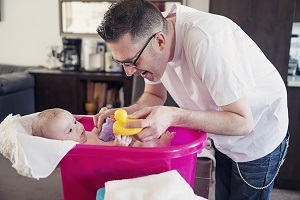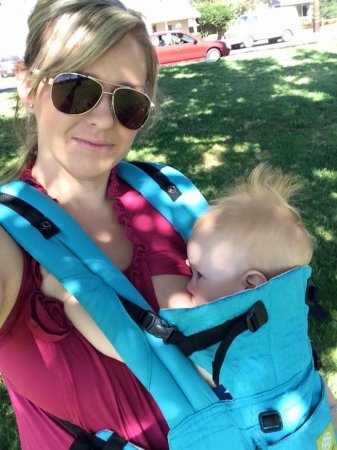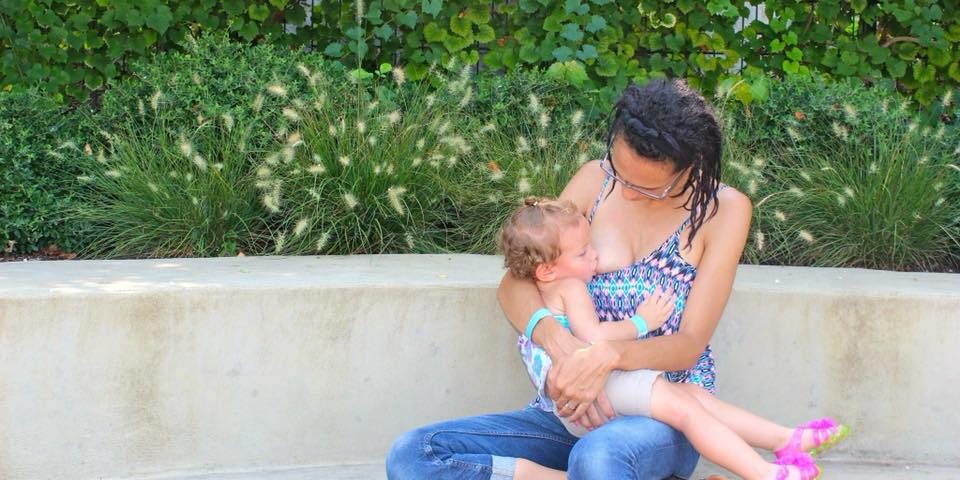One of the desirable benefits of breastfeeding is the bond. Whenever I ask parents why they want to breastfeed, undoubtedly bonding comes up as a top reason. Attachment and bonding go hand in hand with breastfeeding, yet attachment and bonding are very different. In addition, how can you achieve attachment and bonding without breastfeeding?
Bonding With Or Without Breastfeeding
Bonding begins during pregnancy. Connecting with the unborn child during pregnancy leads to stronger bonding in the immediate postpartum period. After baby is born, bonding begins with skin to skin contact and can provide a foundation for secure attachment. It has been defined specifically as the process of an emotional tie of a mother to her baby, gradually unfolding in the first year of the baby’s life. Bonding increases the parents’ response and sensitivity to their baby’s needs, increasing attachment. We know breastfeeding increases the emotional connection between mother and baby, therefore increasing the bond between mother and child.
When Bonding Is Tough
Bonding doesn’t come easily for some parents. Various interruptions can disrupt the bonding process, such as postpartum depression, anxiety, lack of social support, and preterm birth. Read more about maternal-infant bonding and its relationships with depressive symptoms to know more.
Attachment With Or Without Breastfeeding
Where bonding is more of an emotional connection, attachment is more physical. Attachment theory comes into play as the infant begins to realize who is responding to their needs. In addition, when an infant has a caregiver who is responsive to their needs, this helps them to feel more secure. The primary function of a child’s bond with parents or caregivers is to provide a secure, safe base from which the child can then explore their surrounding environment. In moments of stress or fear, children will respond in various ways depending upon the kind of attachment relationship they have with a primary caregiver (Fearon et al. 2015). Attachment, like bonding, can be achieved with or without breastfeeding.
Attachment And Social Emotional Behavior
Research tells us attachment has been proven to be a strong predictor in the social and emotional behavior of children throughout the lifespan. There are several types of infant-parent attachment to know about.
Bonding Without Breastfeeding
Sometimes parents question whether or not other members of the family will be able to bond with the baby. The concern is if breastfeeding will dominate the bonding process. This is absolutely not the case. There are many ways to bond with a baby without breastfeeding.
Bathing
Bath time for babies is a fun and interactive time. There is nothing better than bathing your little bundle, snuggling them up in a towel, and doing some skin to skin before getting them dressed. The emotional connection will grow deeper each time.

Baby Wearing
I love seeing various members of the family wearing the baby in a carrier or wrap. This keeps the baby close and connected, creating an emotional bond that will benefit both baby and caregiver.
Tummy Time
Tummy time is when you place the baby on their stomach on a blanket on the floor for several minutes a day (waking hours only, please). It is important for muscle development. It’s also important for babies to get a break from lying on their back. This can cause flat spots on their heads and decreased muscle development. In the early postpartum period, tummy time can be done on a caregiver’s chest. All you have to do is place the baby on your chest while lying down.
Bonding During Tummy Time
This is a great time to talk with your baby, encourage eye contact and emotional bonding. Just be sure not to fall asleep in this position, because that can be unsafe. As the baby gets older and doing more tummy time on the floor, you can help engage with them by lying on the floor with them, playing with toys, and making eye contact. You can read more about tummy time here.

Attachment And Breastfeeding
You might be wondering why attachment and breastfeeding are connected. We know breastfeeding and bonding are connected emotionally. But what about attachment? The very act of breastfeeding is not only about food. Babies that are breastfed end up spending more time being held, making eye contact with their parent, having needs met. Researchers have found that babies who are exclusively breastfed may encourage maternal emotional care, resulting in greater security and attachment. You can read more about that here.
Attachment Without Breastfeeding
Attachment to your baby can happen without breastfeeding. We know that breastfeeding, and the responsiveness that follows is a foundation for attachment. However, what about other family members? Here are some ways to achieve and secure a solid attachment with a baby without breastfeeding.
- Holding baby often and / or keeping them in a carrier. You can never spoil a baby. If the baby is with you, and let’s face it – a carrier is the best way to do this – they will feel safe and connected. Carriers make it possible for babies to be close but still hands-free to get things done.

- Baby-led feedings. Listen and watch for baby’s cues for feeds instead of keeping them on a strict schedule. If you are responding as needed, this will heighten the concept that you are sensitive to the baby’s needs.
- Sensitive response to outbursts and/or negative emotions. All this means is that you are responding to your baby when they cry. Babies communicate through crying, and they are trying to tell you something. By responding when they cry (picking them up, nurturing, cuddling, feeding, changing a diaper) you are teaching them attachment and assuring them they can feel secure with you.
- Keeping baby close at night. Just because it’s night time doesn’t mean your baby is ok with being alone. By keeping baby close, either in the same room with you or by safe co-sleeping it is easy to respond to their needs quickly.
A Mother’s Story
I had a client I worked closely with last year, an amazing mother of 2 boys. Breastfeeding did not work out with her first son. Lack of support led her to abandon breastfeeding in the first few weeks. With her second baby, breastfeeding was a much more rewarding experience. She often talks about how she feels bad about not breastfeeding her first baby, but spent much of her time building attachment in other ways, including responsiveness and baby massage. She is grateful she found ways to achieve attachment and bonding, with or without breastfeeding.
Benefits Of Attachment With Or Without Breastfeeding
Researchers have been studying the effects of attachment for years. It has been noted that attachment practices from birth have minimized stress for the infant. Chronic stress during early development can be detrimental for a baby and for brain development. Decades of research have taught us that early attachment and its benefits carry through the lifespan. When looking at children who came from an attached background, they showed common behaviors.
Habits Of Attached Children
- responding in a more flexible way when placed in a frustrating situation
- seeking help from adults more appropriately
- showing more persistence and enthusiasm in problem solving situations
- having greater competence in interaction with peers
- greater understanding of both your and other’s emotions.
My Experience
When I think back to when my kids were babies, bonding and attachment were foreign to me. Achieving bonding and attachment either with or without breastfeeding was unknown. What I did was based on intuition – feeding my babies when they showed signs of hunger, snuggling them when they cried, picking them up as needed. In addition, I kept them close and responded to their cues. Like most parents, I was following my instincts and hoped for the best. However, there were some moments when I was not the most responsive parent.
Finding Balance
Looking at my kids now, they show some qualities of an attached child, and I am happy about that. It is very hard to be a parent, let alone be as responsive as you think you should be. There are bound to be days when you need a break. What about all the working parents who are away from their children most of the day? Can you have the date nights, weekend getaways, and kid-free moments that are so detrimental to a parents’ mental health? All of that is ok, and doesn’t make you a parent who is not attached to their child. It makes you normal.
References
Gibbs, B.G., Forste, R. & Lybbert, E. Breastfeeding, Parenting, and Infant Attachment Behaviors. Matern Child Health J 22, 579–588 (2018). https://doi.org/10.1007/s10995-018-2427-z
Katja Linde, Franziska Lehnig, Michaela Nagl, Anette Kersting The association between breastfeeding and attachment: A systematic review, Midwifery, Volume 81,2020.
Lutkiewicz K, Bieleninik Ł, Cieślak M, Bidzan M. Maternal-Infant Bonding and Its Relationships with Maternal Depressive Symptoms, Stress and Anxiety in the Early Postpartum Period in a Polish Sample. Int J Environ Res Public Health. 2020;17(15):5427. Published 2020 Jul 28. doi:10.3390/ijerph17155427
Miller, P., & Commons, M.L. (2010). The benefits of attachment parenting for infants and children: A behavioral developmental view. The Behavioral Development Bulletin, 16, 1-14.
R.M. Pasco Fearon, Glenn I Roisman, Attachment theory: progress and future directions, Current Opinion in Psychology,Volume 15,2017,Pages 131-136.





